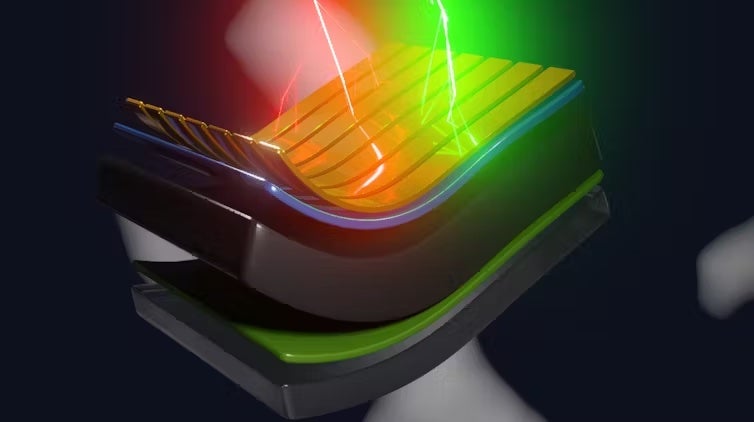
A diagram of a perovskite solar cell. Credit: Ahmad Kirmani using Blender.
The space environment is harsh and full of extreme radiation. Scientists who design spacecraft and satellites need materials that can withstand these conditions.
in a article published in January 2024, my team of materials researchers showed that a next generation semiconductor material called metal halide perovskite actually can recover and heal of damage caused by radiation.
Metal halide perovskites are a class of materials discovered in 1839 which are found in abundance in the earth's crust. They absorb sunlight and efficiently convert it into electricity, making them a potentially good choice for space solar panels that can power satellites or future space habitats.
Researchers make perovskites in the form of inksThen coat the inks onto glass or plastic plates, creating thin, film-like devices that are lightweight and flexible.
Surprisingly, these thin film solar cells perform as well as conventional silicon solar cells in laboratory demonstrations, even though they are almost 100 times thinner than traditional solar cells.
But these films can degrade if exposed to humidity or oxygen. Researchers and industry are currently working to address these stability issues to ground deployment.
To test how they would hold up in space, my team developed a radiation experiment. We exposed perovskite solar cells. to protons at both low and high energy and found a new and unique property.
The high-energy protons healed the damage caused by the low-energy protons, allowing the device to recover and continue doing its job. Conventional semiconductors used in space electronics do not exhibit this healing.
My team was surprised by this finding. How can a material that degrades when exposed to oxygen and moisture not only withstand harsh weather conditions? space radiation But also self-healing in an environment that destroys conventional silicon semiconductors?
In our article, we begin to unravel this mystery.
Because it is important
Scientists predict that satellites will be launched into near-Earth orbit in the next 10 years will increase exponentiallyand space agencies like NASA aim to establish bases on the moon.
Materials that can tolerate extreme radiation and self-heal would be a game-changer.
Researchers estimate that deploying just a few pounds of perovskite materials in space could generate up to 10,000,000 watts of power. It currently costs around $4,000 per kilogram ($1,818 per pound). to launch materials into spaceso efficient materials are important.
What is not yet known
Our findings shed light on a remarkable aspect of perovskites: their tolerance to damage and defects. Perovskite crystals They are a type of soft materialmeaning that its atoms can move to different states that scientists call vibrational modes.
The atoms in perovskites are usually arranged in a lattice formation. But radiation can knock atoms out of position and damage the material. The vibrations could help reposition the atoms into place, but we're still not sure how exactly this process works.
Whats Next?
Our findings suggest that soft materials could be exceptionally useful in extreme environments, including space.
But radiation is not the only stress that materials have to withstand in space. Scientists still don't know how perovskites will fare when exposed to vacuum conditions and extreme temperature variations, along with radiation, all at the same time. Temperature could play a role in the healing behavior my team observed, but we'll need to do more research to determine how.
These results tell us that soft materials could help scientists develop technology that works well in extreme environments. Future research could delve into how the vibrations of these materials relate to the self-healing properties.
He Research Summary It is a short version of an interesting academic work.
This article was first published in He ConversationIt is reproduced here under a Creative Commons license.